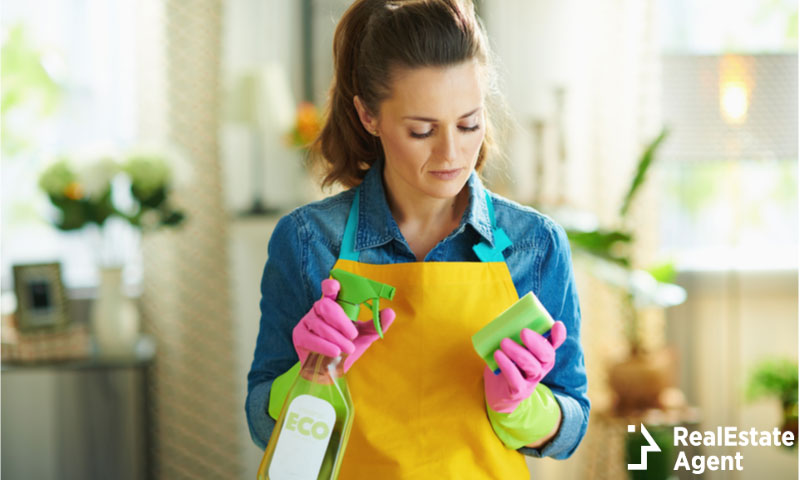For most homeowners, their homes are a source of pride. In many ways, becoming a homeowner is like crossing a threshold. The property is solely your responsibility, and you are the one that needs to make sure that the property is safe and comfortable for everyone that sets foot in it.
The first thing homeowners want to ensure is that the home is safe from any exterior threats. Now, these might be anything from weather-related damages to property crimes. For these threats, many homeowners look into the most reliable home security systems. But, while we do everything we can to protect our homes from exterior threats, we overlook the dangerous items we have inside our homes. Some of these household items are used on a daily basis or are implemented throughout the home, and many of us are unaware of the effect they can have on our health.
Dangerous Items at Home
Ensuring your home is a safe and comfortable space for anyone who uses it takes more than an innovative home security system and triple-paned windows. The ways through which we maintain our homes are also important. When it comes to the things we have and use around our home, we need to understand that not all of them are meant to protect our health. Many of the products we use to clean our homes contain toxic chemicals, but even the materials that other household items contain can endanger our health. Furthermore, using some household items can expose our homes to harmful gasses or radiation.
The good news is that we can replace these dangerous household items or stop using them altogether. We are not dependent on them to live. They simply make our lives easier. Still, is an extra level of comfort worth the potential dangerous exposure? Let’s see what can be eliminated and what can be replaced throughout our homes to decrease the amount of danger we expose ourselves to.
Cleaning Products
Maintaining a clean home should not put our health at risk. Whether you want to clean your carpet, floor, glass, or oven, store-bought cleaning products are not the safest for your health. We aren’t even referring to ingesting these products, but simply using them to clean your home will release toxic chemicals into the atmosphere. That atmosphere is the air inside our homes.
The most dangerous chemicals used in cleaning products are ethylene-based glycol ethers and terpenes. The University of California at Berkeley discovered that if these products are used in excess or in a small room that isn’t properly ventilated, they can release toxic levels of pollutants, exposing us to potential dangers. They detected risks such as asthma or pulmonary function decline in professional cleaning workers and non-professional domestic household cleaners. The risk of exposure increases with the amount of product used and the frequency of use. In other words, the more we use those products to clean our homes, the more exposed we are to their chemicals.
Cleaning our homes should not pose a risk to our health, and while switching to safer alternatives might need some adjustment, it’s not complicated. There are, however, alternative cleaning products that eliminate the risk of exposure to toxic chemicals as they are 100% natural. Ingredients like soap nuts, conkers, lemon, salt, and vinegar can eliminate grease without putting our health at risk.
Non-Stick, Water-Resistant, Stain-Repellent
While the most famous products that use these chemicals are the non-stick pots and pans manufactured at first by DuPont under the name Tefal, PFAS chemicals are present in more household items than we think. Non-stick cookware products are appealing simply because you won’t have to scrub them for half an hour every time you use them as nothing sticks to them. Not even the chemical that makes them non-stick, in fact. Those chemicals, also known as forever chemicals, wind up in our food and, eventually, our bodies. They are highly toxic and the cause of one of the largest corporate lawsuits in US history.
These chemicals aren’t only used in cookware but also utensils, carpets, furniture textiles, and clothes. Furniture manufacturers use them to protect the textile from stains, while some, like IKEA, stopped using them in 2016. As already mentioned, these chemicals don’t stick to the material on which they are used but wind out in the atmosphere and everything else that gets in contact with them. They get into our bodies through contaminated food, water, and air, but our bodies can not eliminate them. In time, these chemicals build up in our bodies, and the higher the quantity of PFAS chemicals in our bodies, the more severe health problems we can experience. However, if we stick to using cast iron, stainless steel, wood, or glass cookware and utensils and take a second look at the kind of treatments the textiles around our homes are exposed to, we can decrease the amount of exposure we are affected by.
Lead-Based Paint
If you look at the lists of chemicals mentioned on your paint container, you might not find lead among the ingredients. However, if you intend to flip a property that is older than 1978, it would be a good idea to figure out whether the paint you have on your walls doesn’t contain lead. In 1991, lead was declared the greatest environmental threat to children by the U.S. government since the compound was used in paint. The effects it can have, however, are not limited to children. Both adults and small children can experience serious health problems from lead exposure. The Environmental Protection Agency established that lead can affect the central nervous system, including the brain, blood cells, and kidney functions. As their immune system is less developed, fetuses, babies, and children are at a higher risk of developmental disorders.
If your house does have lead-based paint, a color renovation might be in order. While intact paint on surfaces won’t kill you, it liberates toxic lead particles that can be inhaled when that paint starts to peel away. Because of this, only a professional should remove lead-based paint as sanding, scraping, or burning it will only release those toxic metals into the air.
These paints were also responsible for the recalls of toys from China in 2007 as many contained lead. The paints available in the US nowadays are regulated, and paints or painted products no longer post health risks due to lead. However, choosing water-based instead of oil-based paints whenever possible will decrease the risk of chemical exposure even more.
Plastics
With how flexible the application of plastic is, it’s no wonder that plastic has found its way throughout our households. You will have a hard time finding any household items that do not contain plastics in one way or another. We could look at obvious kitchen objects like food containers, small kitchen appliances, packaging, or large appliances such as refrigerators and washing machines. It’s not difficult to discover the amount of plastic contained in common household items, but it will be challenging to eliminate them. This is not only because we can not recycle most of these plastics but also because we can replace not all of them with other alternatives.
Vrije Universiteit Amsterdam in the Netherlands organized a study in order to determine if humans are affected by microplastics. While these microplastics can be found in ocean waters due to the slow decomposition of plastics, they are also released from products we have around our homes. Plastic fiber clothes, plastic bottles, polystyrene food packaging, or microwavable plastics all release microplastics that wind up in our food and, eventually, our bodies. Professor Vethaak went as far as to declare to the Guardian that “It is certainly reasonable to be concerned” after 80% of the people tested were found to have blood contaminated by these microplastics. Furthermore, 25% of the tested blood samples contained polyethylene, included in plastic carrier bags.
How can Dangerous Household Items Impact Our Health?
Most cleaning products and household items can have adverse effects on our health. While some cause eye, throat, or skin irritation that we can solve with a thorough wash, others cause headaches or more severe health problems like cancer. Volatile Organic Compounds (VOCs), ammonia, and bleach are the most common chemicals in cleaning supplies. However, even some natural fragrances (citrus) can cause a chemical reaction when combined with these or high ozone levels and result in some dangerous indoor pollutants.
The most common cleaning and household products that can include these harmful chemicals are:
- Aerosol spray products (air freshener, hair spray, laser printers, pesticides);
- Chlorine bleach;
- Dry or liquid cleaning products.
Maintaining a clean and healthy home shouldn’t put our health at risk. Chemicals present in cleaning products, including VOCs, can cause chronic respiratory problems, headaches, allergic reactions, asthma, or other respiratory problems. Furthermore, combining bleach-containing products with cleaning products that contain ammonia can lead to chronic breathing issues and even death.
Preventing Harmful Effects of Household Items
If you want to make sure that you don’t bring more toxic chemicals into your home than is absolutely necessary, there are a few things you can do. Cleaning products and household items have labels that specify what types of chemicals and materials are contained in them. The main chemicals you want to keep away from your home are VOCs, irritants, fragrances, and flammable ingredients. We should avoid air fresheners altogether due to the chemicals they contain.
Greenwashing is common in marketing strategies, and many companies lie about their so-called “green” products. Products must have labels. However, the problem with labels is that manufacturers are not required by law to list all of the ingredients contained in their products. Because of this, you can never be 100% sure that the product you purchase is 100% chemical or toxins-free. The consumer might see labels that specify “all-natural”, “green”, or other similar terms, but these labels are not verified unless they have to be. Even in the PFAS chemical lawsuit, the EPA did not verify the compounds used in Teflon until the population got sick.
Actually, safe cleaning products can be made at home with some essential cooking ingredients and basic soaps. Things like vinegar, baking soda, lemon, water, castile soap, conkers, soap nuts, and alcohol can clean our homes without exposing us to toxic chemicals. Another trick is to simply make sure your home is well ventilated during your cleaning spree. Open the windows and doors to allow fresh air to circulate and avoid using chemically packed cleaning products in small enclosed spaces.
Conclusion
When it comes to the products we use to maintain our homes clean, keeping away from toxic chemicals has less to do with the environment and more with our health. While the two work together at all times, it is much easier to make sure that your home is free of pollutants than it is to ensure the planet is pollution-free. While our modern lifestyle has a negative impact on the environment, we, as a collective, can change that if we take action. Whether this change comes from the cleaning products we use or the community as a whole, the responsibility doesn’t fall entirely on the consumer’s shoulders. Much larger entities dictate how the planet’s resources are abused, and governments together with industries should take action now before it’s too late.
While these are some of the things that can limit the amount of pollution your household is exposed to, there are many other things that each individual could do to limit their carbon footprint. Implement sustainability throughout your home, and you won’t only decrease your carbon footprint but also take some of the pressure off your finances. Keep in mind that more doesn’t always mean better, and we don’t need as much as we purchase, no matter what marketing campaigns might say.
Whatever your thoughts are on this subject, let us know in the comments below, as we all want to live a healthy and happy life. Like & Share this article with friends and family as these products have a way of affecting each and every one of us if we don’t do something about it.















